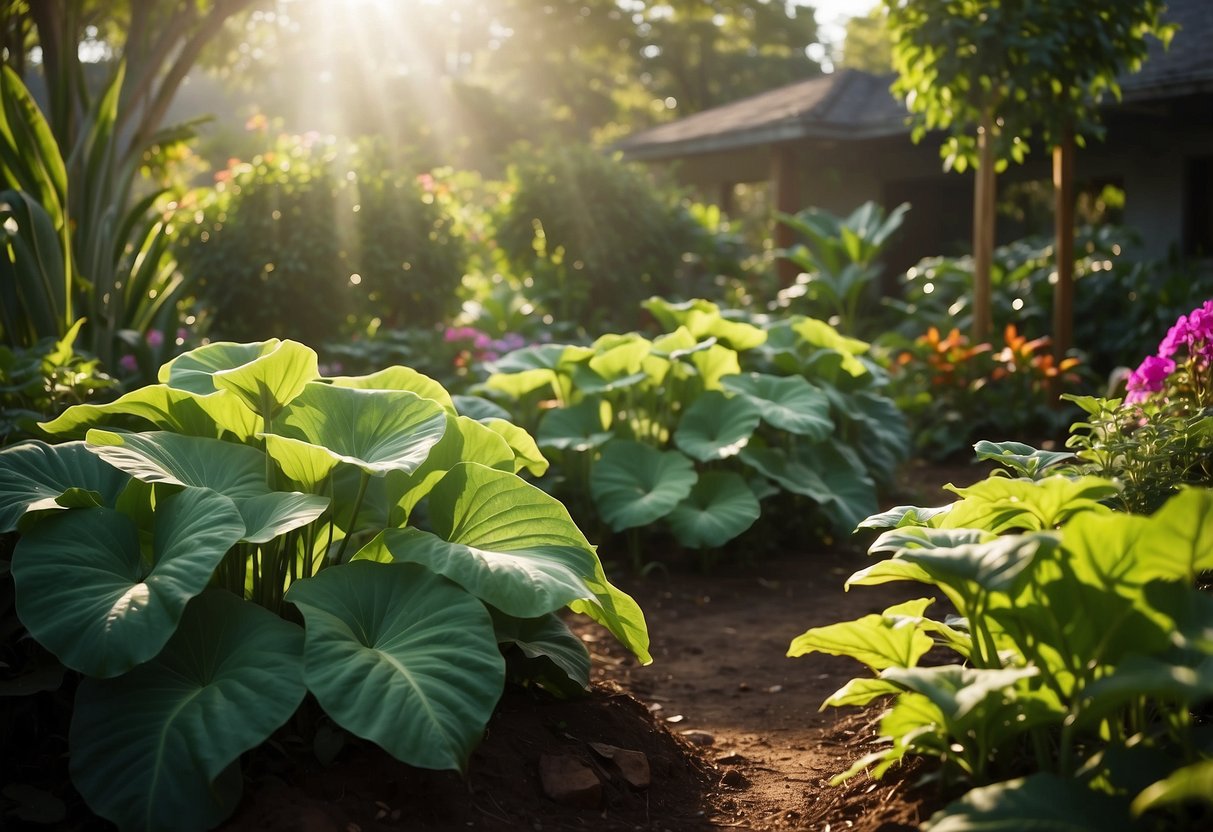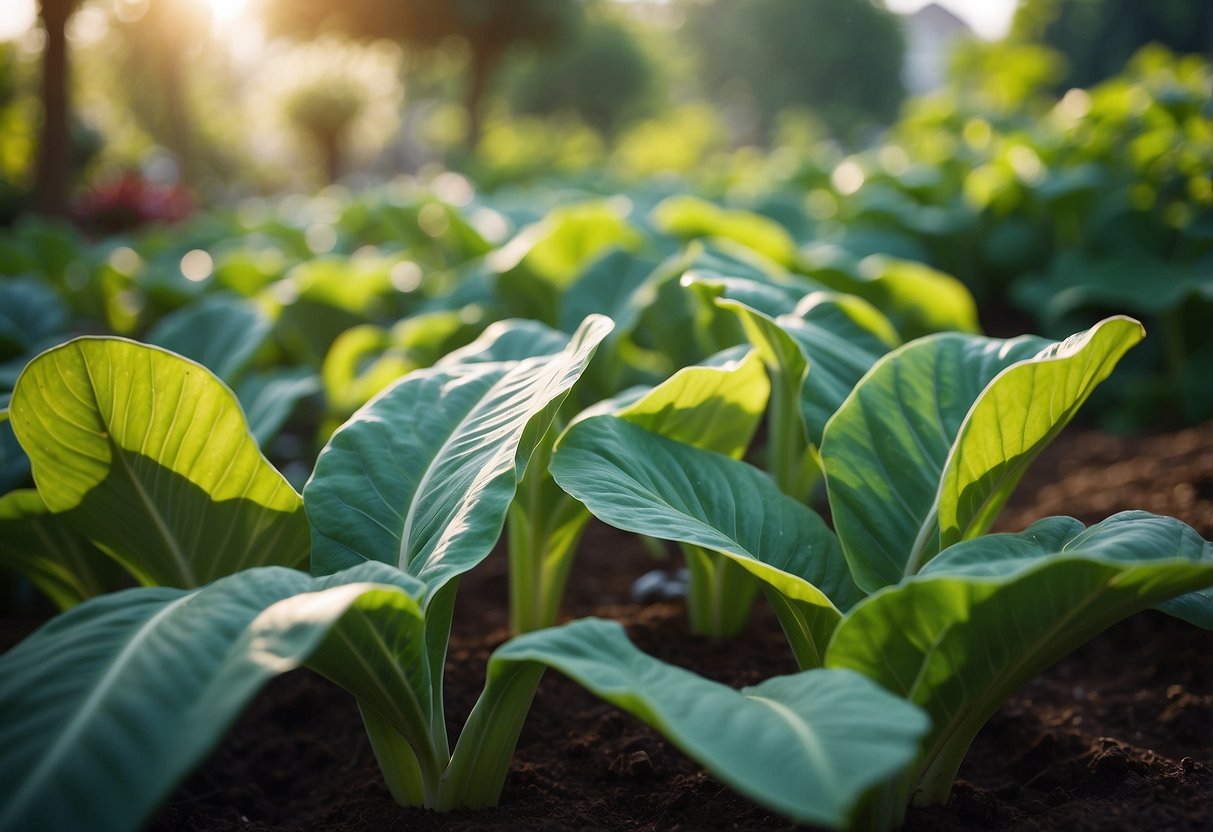Elephant Ear Garden Ideas: Creative Ways to Beautify Your Yard
Elephant ear plants are a fantastic addition to any garden, bringing a touch of the tropics to your outdoor space. With their large, heart-shaped leaves, they create a lush, exotic atmosphere that’s sure to impress. But did you know that there are different types of elephant ear plants you can grow?

You can incorporate these plants into various garden designs, from shady corners to vibrant container gardens. Whether you’re looking to add drama with their striking foliage or just want a unique focal point, elephant ear plants offer plenty of creative possibilities.
1) Planting Elephant Ear Bulbs

To start planting elephant ear bulbs, pick a sunny spot with temperatures above 55°F. Adding 2 inches of compost helps, as these plants thrive in rich organic soil.
Plant your bulbs after frost has passed. Place them 5 inches deep, with the end with concentric circles facing upwards. If unsure, plant on the side; it will grow correctly.
Space bulbs 2 to 4 feet apart for good growth. Keep soil consistently moist, but avoid waterlogging to prevent rot.
2) Growing Elephant Ears in Containers

Growing elephant ears in containers is a fun way to add a tropical vibe to your space.
Start with a large pot to give the plant plenty of room to grow. Use a high-quality soil mix that includes peat moss, compost, and perlite.
Place the pot in a spot with bright, indirect sunlight.
Check the container daily and water it often to keep the soil moist.
You can fertilize the plant once a month to boost growth.
3) Creating a Tropical Garden Theme

To create a tropical garden theme, start by planting elephant ears in groups. Their large, lush leaves instantly give a jungle feel. Place them in sheltered areas to protect them from strong winds, as winds can tear the leaves.
Pair elephant ears with other tropical plants like cannas or hibiscus. This mix adds vibrant colors and different textures to your garden. To enhance the tropical effect, consider planting varieties like ‘Blue Hawaii’ or ‘Thailand Giant’ with their unique leaf patterns and sizes.
4) Water Features with Elephant Ear Plants

Adding elephant ear plants to your water features can create a lush, tropical look.
Place the plants around ponds or fountains for a natural vibe.
Consider growing elephant ears in water directly by submerging the tubers in pots.
Ensure the soil stays moist by placing the pots under the water surface.
This setup adds visual interest to any garden space.
5) Elephant Ears as Focal Points

Elephant ears make stunning focal points in your garden with their large, dramatic leaves. Position them in garden beds or lawns where they can stand out.
These plants can also be used to anchor mixed containers. Their large, glossy leaves highlight plants with contrasting forms, shapes, and sizes, creating visual depth. Keep the soil moist and mist the foliage to maximize humidity.
For more ideas, check out these tips on growing elephant ears.
6) Using Elephant Ears for Privacy Screens

Elephant Ears are great for creating privacy in your garden. Their large, lush leaves can form a natural barrier that adds both beauty and function to your outdoor space.
Plant them in rows to create a dense screen. They grow quickly and can fill in gaps within a season, giving you a lush, green wall.
Choose a spot with partial to full shade and moist soil. This will help them thrive and provide the best coverage. Water the plants regularly to keep the soil consistently moist for optimal growth.
7) Elephant Ear Varieties to Try

Alocasia is a popular choice with its calla lily-like blooms and arrow-shaped leaves. The foliage can have black, bronze, or dark purple streaks, adding a touch of elegance to your garden.
Consider Alocasia ‘Regal Shields’ for its heart-shaped leaves that are bright green with darker purple veins. This variety stands out beautifully in any tropical-themed garden.
Hawaiian Punch features green foliage with rhubarb-red stems. It grows fast and reaches up to four feet, perfect for adding vibrant color to your garden. Check out more about Hawaiian Punch for zones 7 through 11.
8) Combining Elephant Ears with Colorful Annuals

Pairing your elephant ears with colorful annuals can create a stunning visual effect in your garden. The large leaves of the elephant ears provide a striking backdrop for the vibrant blooms of annual flowers.
Consider planting marigolds or petunias around the base of your elephant ears. These flowers add pops of color that contrast beautifully with the lush green foliage.
Impatiens can also be a good choice. They thrive in similar conditions as elephant ears, enjoying shade and moisture. This combination can make your garden feel like a tropical paradise.
9) Elephant Ears in Raised Beds

Growing elephant ears in raised beds is a fantastic idea. Raised beds offer better drainage, which is essential since these plants love moisture but dislike waterlogged roots.
You can control the soil quality more easily in a raised bed. Mixing in compost and other organic material helps the plants thrive.
Raised beds also make it easier to manage weeds and pests. You can plant companion plants like chamomile to ward off pests and diseases, ensuring your elephant ears stay healthy.
10) Designing Shade Gardens with Elephant Ears

When designing a shade garden, elephant ears bring bold texture and lush greenery.
Mix them with plants of varying heights and colors to create depth.
You can pair them with plants like sweet potato vines or Persian shield for contrast.
Choose spots with moist, well-drained soil and partial to full shade.
For more ideas, check out these shade garden design ideas.
Choosing The Right Elephant Ear Varieties

Selecting the right elephant ear varieties depends on factors like the specific type of plant and the climate conditions in your garden. Knowing these details can help you make the best choice for a vibrant and healthy garden.
Types of Elephant Ear Plants
There are various types of elephant ear plants. Alocasia and Colocasia are the most common.
Alocasia plants have arrow-shaped leaves that often point upwards. They can grow up to six feet tall and have striking colors like black, bronze, or dark purple.
Taro or Colocasia esculenta is another popular type, known for its culinary uses. This plant has heart-shaped leaves that point downward.
Hawaiian Punch is a colorful variety with green leaves and rhubarb-red stems. It grows well in zones 7 through 11 and can reach 2 to 4 feet tall.
Climate Considerations
Elephant ears thrive in tropical and subtropical climates. If you live in USDA zones 7 through 11, you can grow them outdoors year-round.
In colder climates, you should plant them in pots that can be brought indoors during winter. Make sure they get plenty of sunlight and moisture.
Alocasia varieties prefer well-drained soil and partial shade. Colocasia, on the other hand, likes wet soil and can even grow in shallow water.
Choosing the right variety for your climate ensures healthy growth and a beautiful garden.
Planting And Care Tips

When growing elephant ear plants, ensure good soil quality with proper drainage and consistent watering to maintain plant health and growth.
Soil Preparation
Elephant ears thrive in moist, well-drained, and organically rich soil. Before planting, loosen the soil to a depth of at least 8 inches. This allows roots to spread out easily and ensures better water penetration.
Compost or manure can be added to improve soil richness. Mix these organic materials into the soil for better texture and nutrients. If your soil is heavy clay, consider adding sand or peat to improve drainage.
Choose a sunny spot with dappled shade. Direct sunlight can scorch leaves, so partial shade is ideal. Plant bulbs with the pointy side up, burying them a couple of inches deep.
Watering Needs
Maintaining consistent moisture is key for healthy elephant ear plants. They prefer regular watering, especially during dry periods. The soil should stay consistently moist but not waterlogged. Over-watering can lead to root rot, so ensure good drainage.
Water deeply a couple of times a week rather than shallowly every day. This encourages deeper root growth. In particularly hot weather, you might need to water more frequently.
Yellowing leaves often indicate a watering issue. If leaves turn yellow, check if the soil is too dry or too wet. Adjust watering accordingly to keep your elephant ears thriving.
Designing Your Elephant Ear Garden

When designing your elephant ear garden, focus on choosing the right companion plants and creating a layout that highlights the dramatic foliage.
Complementary Plants
Pair elephant ear plants with other tropical plants for a lush look. Ferns add texture and create a layered effect. Hostas offer contrasting leaf shapes.
Caladiums bring in vibrant colors to complement the green elephant ear leaves. Begonias provide spots of bright flowers. Ground cover like creeping Jenny can complete the look by filling in gaps.
Choose plants with different heights and textures. This diversity adds depth and interest to your garden.
Creative Layout Ideas
Place taller elephant ear plants at the back or center of your garden. This helps create a focal point. Arrange shorter plants like hostas and caladiums around them.
Consider planting in clusters for a natural look. This mimics how plants grow in the wild. Use curved pathways or borders for a more organic feel. Incorporate decorative elements like stone paths or water features to enhance the tropical atmosphere.
Mix and match plant colors and textures to create visual interest. This approach ensures your garden remains captivating throughout the seasons.







